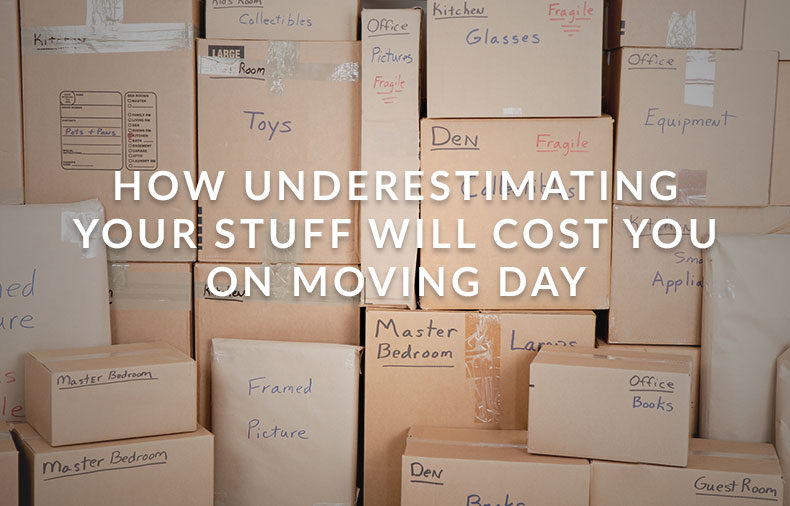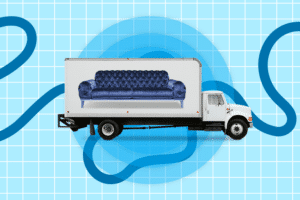One of the top issues household moves transporters face on uShip is customers who grossly underestimate their actual volume of stuff compared to what’s described in their uShip listing. As I’ve discussed this with transporters, I’ve always made a mental note to avoid being “that guy” on my personal moves.
Well, recently, I was “that guy.” And it hit me in the wallet.
This was for an Austin-to-Houston move I was managing for my elderly in-laws. When posting the shipment listing on uShip, I classified it as a 1BR Bedroom move based on memory (I wasn’t there in person) and the fact that they lived in a one bedroom condo. As I ultimately learned, I was pretty far off. My in-laws had enough stuff to fill at least a Large 1BR, maybe even a 2BR. So much for down-sizing.
Hidden Moving Costs, So, why write about it?
I decided to write this post in hope of helping people avoid my inconvenient — and costly — truth. Moving is stressful enough, and it only makes it more so when a pint-sized truck shows up to haul a gallon-sized household and hidden moving costs arise.
Let’s face it, we Americans have too much crap. Way more than you might think. And probably a lot more than we need but that’s a post for another day.

Here are my 3 tips for avoiding hidden moving costs and dealing with Underestimator Syndrome:
Get It Right the First Time to Avoid Hidden Moving Costs.
Prior to posting on uShip, take a few minutes to seriously figure out how much stuff you’ve really got. Physically, not just mentally. Walk through the house or apartment, room by room. Write it down. Take pictures. This includes storage units.
Think you’ll have “maybe 20 boxes or so” once you’ve finished packing? Double it. You’ll thank me later. Got 3 or 4 chairs? It’s probably more like 8. Books? Oh, your precious books. They’re heavy and fill up boxes faster than you can say, “Where’s my Kindle?”
And don’t conveniently exclude the patio furniture, planters, workbench, or that broken neon Coors Light “Silver Bullet” sign from college, thinking the mover can just “toss it in at the end.” It doesn’t work that way. Your poor planning cuts into their livelihood.
Use ‘Additional Details’ and Photos to Avoid Hidden Moving Costs.
When posting your shipment listing on uShip be sure to add your detailed list of items — box quantity and size, wall hangings, appliances, lawn mowers, standing lamps, the vacuum, everything — to the Additional Details section. This will put it in writing so you’re covered if the transporter shows up with a Sprinter van for your 3BR house move.
Likewise, if you list a Sprinter van’s worth of stuff when you’re trying to move a 3BR house, you’ll be the one holding the bag, not the transporter. By the way, you’ll find your checkbook in the kitchen drawer — you’re gonna need it.
Also use uShip’s Photo feature to show several key items. Of course, you don’t need to take a picture of a standard queen size bed, but if something is abnormal in size, weight or dimension, that whole “picture’s worth a 1000 words” thing comes in real handy.
For example, “queen bed” is great, but if it’s a waterbed, take a photo. And putting “statue” on your list is nice, but when it’s a priceless, 350 lb bust of Ben Franklin, a picture goes a long way toward avoiding problems on moving day.
Remember, Mistakes Happen.
Work Through It. With 40 million Americans moving every year, there’s bound to be a lot of these situations where the estimates just don’t match the truck making the move. Often times, van lines send out estimators, but on uShip, from my experience working with one-man-band owner-operators, that rarely happens.
It just requires a few more details to make sure it’s accurate. So if you find yourself in a situation where you’ve grossly underestimated your stuff and the truck and/or trailer simply can’t take it all, it’s important that you stay calm and work through the problem. It’s no use getting mad at the transporter — they were just going based on your data.
As hard as it is to do, simply admit your mistake (remember, you don’t do this every day) and work with the transporter to solve the problem. You might be surprised how willing they are to work with you. That said, it’s probably going to be a hidden moving cost to make the additional truck space happen.
How do I know?
I know because it cost me for the transporter to rent a separate truck to make the move. We calmly thought through and discussed options, and in a few minutes, started working on a solution with clear expectations and timing in mind. It removed potential tension from the situation and we got my in-laws settled, albeit delayed due to my error, but settled nonetheless.
Dean Jutilla does communications for uShip and has been with the company since 2009.




